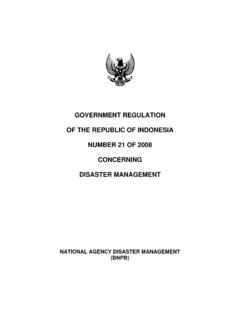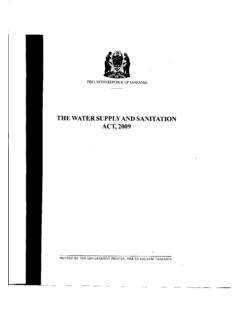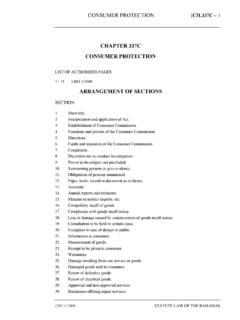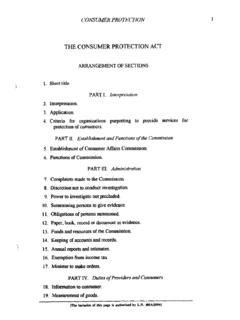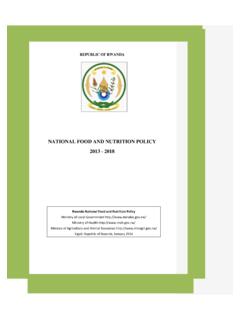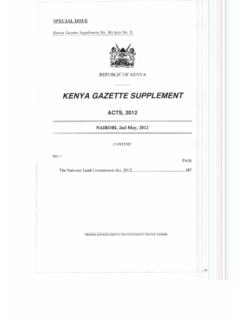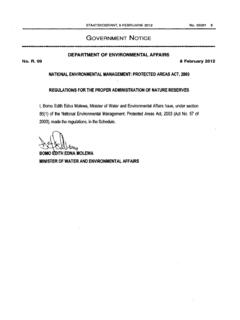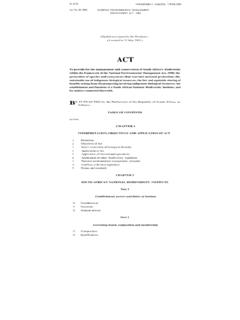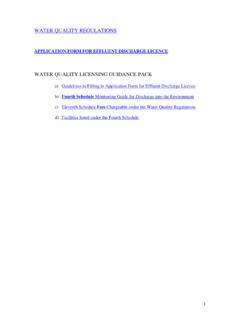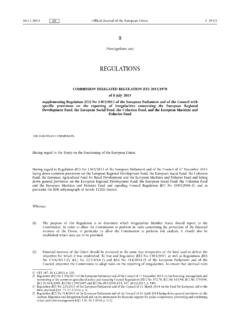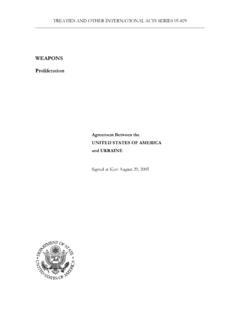Transcription of HEAVY METALS REGULATIONS - Food and Agriculture …
1 Art. 1 Short Title LEGAL NOTICE No 66/2003 HEAVY METALS REGULATIONS PART I PRELIMINARY These REGULATIONS may be cited as the " HEAVY METALS REGULATIONS Legal Notice No 66/2003". Art. 2 Scope of Application ( 1) These REGULATIONS lay down the measures for the monitoring of the HEAVY METALS : Mercury, Lead and Cadmium in fishery and aquaculture products. (2) The basic purpose for the establishment of sample preparation procedures and criteria of methods for analysis is to obtain a representative and homogenous laboratory sample without introducing secondary contamination so as to obtain representative results for the determination of the levels of the contaminants which may be heterogeneously distributed in a lot.
2 (3) The provisions for the sampling and methods of analysis have been drawn up on the basis of present knowledge and they may be adapted to take into account the advances in scientific and technological knowledge. Art. 3 Sampling (1) The Fish Inspection and Quality Control Division (The Competent Authority (CA)) of the ministry of Fisheries shall take all measures necessary to ensure that the sampling for the official control of the levels of lead, cadmium and mercury in fishery and aquaculture products is carried out in accordance with the methods described in this part of the REGULATIONS .
3 (2) The Fish Inspection and Quality Control Division (CA) of the ministry of Fisheries shall take all measures necessary to ensure that the sample p:--eparation and methods of analysis for the official control of the levels of lead, cadmium and mercury in fishery and aquaculture products shall comply with the criteria described in Part IV of these REGULATIONS . PART II SPECIFICATIONS, LIMITS and MAXIMUM LEVELS Art. 4 Mercury content (1) The mean total mercury content, as determined by the analysis of the edible parts of the fishery products shall not exceed ( of fresh weight}.)
4 (2} This average limit is, however, increased to: 34 1 ppm (1 mg/kg of fresh weight) for the edible parts of the following species: Lophius (Anglerlish) Anarhichas lupus (Atlantic catfish) Dicentrarchus labrax (Bass) Malva dipterygia (Blue ling) Sarda spp (Bonito) Anquilla spp (Eel) Hippoglossus hippoglossus (Halibut) Euthunnus spp (Little tuna) Makaira spp (Marlin) Esox lucius (Pike) Orcynopsis unicolor (Plain bonito) Centroscymnes coelolepis (Portuguese dogfish) Raja spp (Rays) Sebastes marinus, S. mentella, S.)
5 Viviparus (Redfish) Jstiophorus platypterus (Sail fish) Lepidopus caudatus, Aphanopus carbo (Scabbard fish) Shark (all species) Lepidocybium jlavobrunneum, Ruvettus pretiosus, Gempylus serpens (Snake mackerel) Acipenser spp (Sturgeon) Xiphias gladius {Swordfish) Thunnus spp {Tuna) Art. 5 Lead content (l} The mean total lead content, as determined by the analysis of the edible parts of the fishery products shall not exceed ( mg/kg of fresh weight). (2) This average limit is, however, increased to: (a) ppm ( of fresh weight) for edible parts of the following species: Dicologoglossa cuneata (Wedge sole) Anguilla anguilla (Eel) Dicentrarchus punctatus (Spotted seabass) Trachurus trachurus (Horse mackerel or Scad) Mugil labrosus labrosus (grey mullet) Diplodus vulgaris (Common two-banded seabream) Pomadasys benneti (Grunt) Sardina pilchardus (European pilchard or sardine) (b) ppm { mg/kg of fresh weight) for.}}
6 Crustaceans (excluding brown meat of crab) (c) 1 ppm (1 mg/kg of fresh weight) for: Bivalve molluscs and Cephalopods (without viscera) Art. 6 Cadmium content (1) The mean total cadmium content as determined by the analysis of the edible parts of the fishery products shall not exceed ppm ( mg/kg of fresh weight. (2) This average limit is, however, increased to: (a) ppm (0. lmg/kg of fresh weight} for edible parts of the following species: 35 Dicologoglossa cuneata (Wedge sale) Anguilla anguilla (Eel) Trachurus (Horse Mackerel or Scad) Mugil labrosus labrosus (grey mullet) Diplodus vulgaris (Common two-banded seabream) Sardina pilchardus (European pilchard or sardine) Engraulis encrasicholus (European anchovy) Luvarus imperialis (Louvar or Luvar) (b) ppm ( mg/kg of fresh weight) for: Crustaceans (excluding brown meat of crab).))
7 (c) 1 ppm (1 mg/kg of fresh weight) for: Bivalve molluscs and Cephalopods (without viscera) PART III METHODS OF SAMPLING FOR OFFICIAL CONTROL OF THE LEVELS OF LEAD, CADMIUM AND MERCURY IN FISHERY AND AQUACULTURE PRODUCTS Art. 7 Purpose and scope Samples intended for the official control of the levels of lead, cadmium and mercury contents in fishery products shall be taken according to the methods described below. Aggregate samples thus obtained shall be considered as representative of the lots or sublots from which they are taken.
8 Compliance with maximum levels laid down in Articles 4, 5 and 6 of Part II hereof shall be established on the basis of the levels determined in the laboratory samples. Art. 8 Definitions A number of the most commonly used definitions in describing methods of sampling are given below: (a) Lot: (b) Sub-lot: (c) Incremental sample: (d) Aggregate sample: (e) Laboratory sample: an identifiable quantity of food delivered at one time and determined by the official to have common characteristics, such as origin, variety, type of packing, packer, consignor or markings.
9 In the case of fish, also the size of fish shall be comparable. designated part of a large lot in order to apply the sampling method on that, designated part. Each sublot must be physically separated and identifiable. a quantity of material taken from a single place in the lot or sublot. the combined total of all the incremental samples taken from the lot or sub-lot. sample intended for the laboratory 36 CHAPTER 1: General provisions for sampling Art. 9 Personnel An authorized qualified person, as specified by the Fish Inspection and Quality Control Division (CA} of the ministry of Fisheries, shall conduct sampling.)
10 Art. 10 Material to be sampled Each lot must be sampled separately. Art. 11 Precautions to be taken In the course of sampling and preparation of laboratory samples precautions must be taken to avoid any changes that would affect the lead, cadmium and mercury contents and adversely affect the analytical determination or make the aggregate samples unrepresentative. Art. 12 Incremental samples As far as possible incremental samples shall be taken at various places distributed throughout the lot or sub-lot. Departure from this procedure must be recorded in the record provided for under Article 13 hereof.
